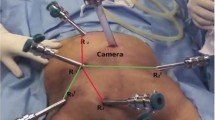Abstract
Attention to nerve identification in rectal cancer surgery began in Japan in the 1970s, but it was an American surgeon [1, 2] between the 1970s and 1980s who proposed a combination of the nerve-sparing principle with the TME technique. The result was the preservation of urogenital function in 90% of the patients treated, without affecting the oncological outcome. Subsequently, the effectiveness, implementation and safety of the technique were confirmed by Moriya’s group [3], and the long-term functional results were documented by the famous Dutch TME trial.
Access this chapter
Tax calculation will be finalised at checkout
Purchases are for personal use only
Similar content being viewed by others
References
Hojo K, Vernava A (1991) Preservation of urine voiding and sexual function after rectal cancer surgery. Dis Colon Rectum 34:532–539
Enker WE (1992) Potency, cure, and local control in the operative treatment of rectal cancer. Arch Surg 127:1396–1401
Maas CP, Moriya Y, Steup WH et al (2000) A prospective study on radical and nerve-preserving surgery for rectal cancer in the Netherlands. Eur J Surg Oncol 26:751–757
Celentano V et al (2010) Prospective study of sexual dysfunction in men with rectal cancer: feasibility and results of nerve sparing surgery. Int J Colorectal Dis 25:1441–1445
Lindsey I (2000) Anatomy of Denonvilliers’ fascia and pelvic nerves, impotence, and implications for the colorectal surgeon. Br J Surg 87:1288–1299
Sartori C (2011) Urinary and sexual disorders after laparoscopic TME for rectal cancer in males. J Gastrointest Surg 15:637–643
Kim et al (2002) Assessment of sexual and voiding function after total mesorectal excision with pelvic autonomic nerve preservation in males with rectal cancer. Dis Colon Rectum 45:1178–1185
Song PH et al (2010) Comparison of the erectile function in male patients with rectal cancer treated by preoperative radiotherapy followed by surgery and surgery alone. Int J Colorectal Dis 25:619–624
Stamopoulos P et al (2009) Prospective evaluation of sexual function after open and laparo-scopic surgery for rectal cancer. Surg Endosc 23:2665–2674
de Calan L, Gayet B, Bourlier P et al (2004) Cancer du rectum: anatomie chirurgicale, preparation à l’intervention, installation du patient. In: Encyclopédie Médico-Chirurgicale 40–606 Editions Scientifiques et Médicales Elseviers, Paris, pp 1–12
Matsuoka N, Moriya Y, Akasu T et al (2001) Long-term outcome of urinary function after extended lymphadenectomy in patients with distal rectal cancer. Eur J Surg Oncol 27:165–169
Moriya Y (2006) Function preservation in rectal cancer surgery. Int J Clin Oncol 11:339–343
Nano M et al (2004) Ligation of the Inferior Mesenteric Artery in the surgery of rectal cancer: anatomical considerations. Dig Surg 21:123–127
Lange MM, van de Valde CJH (2010) Long-term anorectal and urogenital dysfunction after rectal cancer treatment. Semin Colon Rectal Surg 21:87–l94
Heald RJ et al (2004) Optimal total mesorectal excision for rectal cancer is by dissection in front of Denonvilliers’ fascia. Br J Surg 91:121–123
Kinugasa Y et al (2006) Operating behind Denonvilliers’ fascia for reliable preservation of urogenital autonomic nerves in total mesorectal excision. A histologic study using cadaveric specimens, including a surgical experiment using fresh cadaveric models. Dis Colon Rectum 49:1024–1032
Lindsey I et al (2005) Denonvilliers’ fascia lies anterior to the fascia propria and rectal dissection plane in total mesorectal excision. Dis Colon Rectum 48:37–42
Da Silva G (2004) The efficacy of a nerve stimulator (Cavermap®) to enhance autonomic nerve identification and confirm nerve preservation during total mesorectal excision. Dis Colon Rectum 47:2032–2038
Asoglu O et al (2009) Impact of laparoscopic surgery on bladder and sexual function after total mesorectal excision for rectal cancer. Surg Endosc 23:296–303
Breukink SO et al (2005) Laparoscopic versus open total mesorectal excision: a case-control study. Int J colorectal Dis 20:428–433
Morino M, Parini U, Allaix ME et al (2009) Male sexual and urinary function after laparo-scopic total mesorectal excision. Surg Endosc 23:1233–1240
Author information
Authors and Affiliations
Corresponding author
Editor information
Editors and Affiliations
Rights and permissions
Copyright information
© 2013 Springer-Verlag Italia
About this chapter
Cite this chapter
Masaro, S., Palmisano, S., Leon, P., de Manzini, N. (2013). Nerve-sparing Technique in Rectal Cancer. In: de Manzini, N. (eds) Rectal Cancer. Updates in Surgery. Springer, Milano. https://doi.org/10.1007/978-88-470-2670-4_8
Download citation
DOI: https://doi.org/10.1007/978-88-470-2670-4_8
Publisher Name: Springer, Milano
Print ISBN: 978-88-470-2669-8
Online ISBN: 978-88-470-2670-4
eBook Packages: MedicineMedicine (R0)




